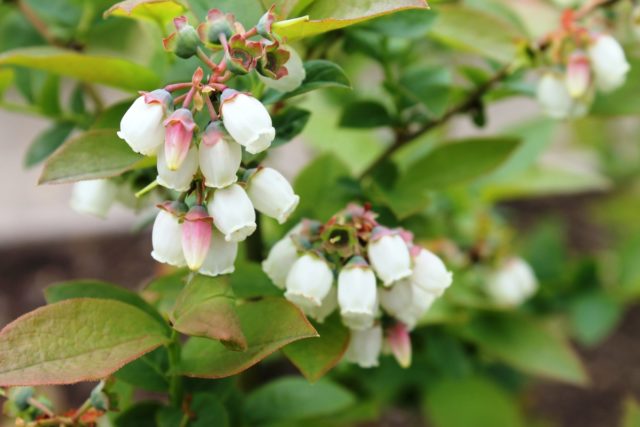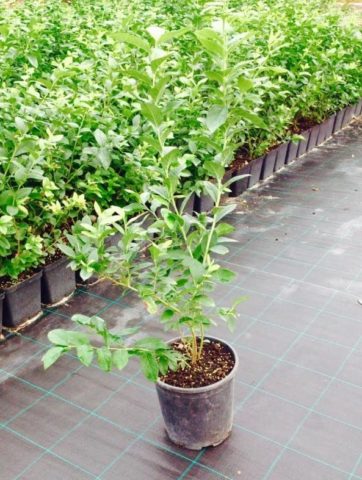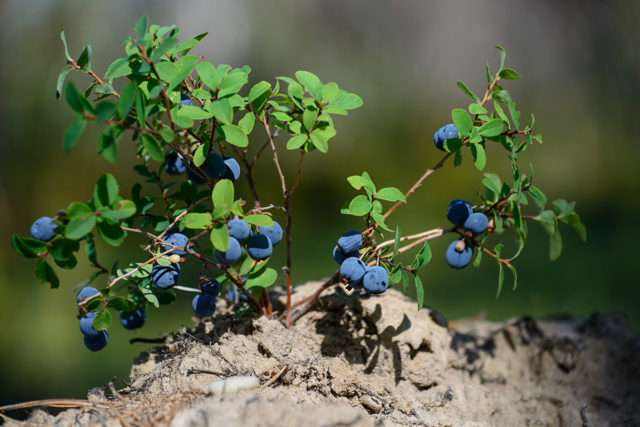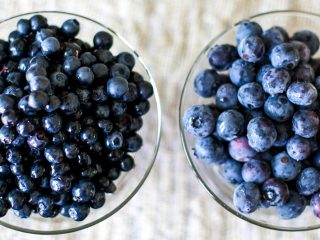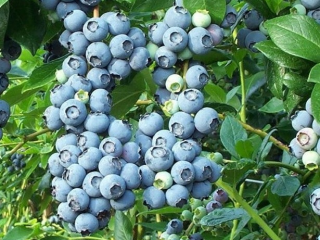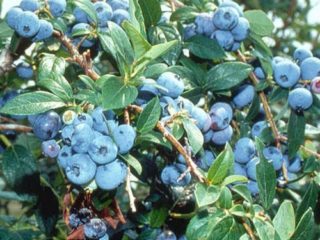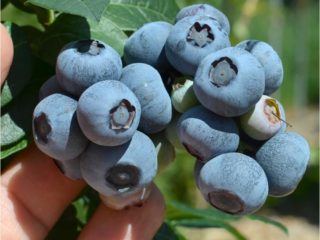Content
Blueberries come from North America, the main cluster of shrubs - on the slopes of mountains, river floodplains, in the undergrowth. Wild species formed the basis for breeding varieties that differ in the size of the bush, the level of fruiting and frost resistance. Blueberry Chandler is one of the first cultivars to appear on the Russian market. The variety was created by European breeders in 1994, adapted to the climatic conditions of the temperate zone.
Description of the variety
Garden blueberry variety Chandler, as pictured above, is a late-fruiting perennial deciduous plant. It belongs to tall varieties, the height of an adult blueberry is 1.5-1.7 m. The shrub is spreading, branched, the crown diameter is 1.5 m.0 C.
The Chandler variety is cultivated in regions with cold winters and in the south. Blueberries are especially popular with gardeners in Siberia, the Urals and the middle lane; they are often found in the gardens of the Moscow region. Chandler blueberries are grown for gastronomic purposes and as a design option. The shrub retains its decorative effect for the entire spring-autumn period from flowering to a change in leaf color. At the end of September, the shrub becomes yellow, then a bright burgundy color, the leaves do not fall until the first snow.
External characteristics of Chandler blueberry:
- A round bush, spreading, forms numerous fast-growing light green young shoots. Perennial stems are completely woody, gray with a brown tint.
- The Chandler blueberry bush is densely leafy, the leaves are 3.5-4 cm long, they are located opposite. The shape of the plate is obovate with a sharp tip. The surface is smooth, hard, with a pronounced light central vein. The cuttings are thick and short.
- The flowers are small, pitcher-shaped. The buds are pink, and after blooming are white, drooping. Abundant flowering.
- Fruit clusters are formed on last year's shoots, the density is from 8 to 12 berries, located on the outer part of the bush.
The root system is superficial, underdeveloped, the roots are thin, fibrous type. They cannot provide food for blueberries on their own. The microelements of the Chandler variety planting necessary for the growing season are obtained from interaction with the mycelium of the fungus, the so-called mycorrhiza, the symbiosis provides nutrition to the mushrooms and shrubs.
Features of fruiting
The high yield of the Chandler variety is ensured by late flowering, it occurs in June, frosts at this time are rare even in the Northern regions. The berries ripen unevenly, the collection continues from August to September. If they do not have time to collect part of the harvest before the first frost, blueberries do not fall off, completely retains their taste and shape.
The first single flowers of Chandler blueberries form in the 3rd year of growth, they are removed from the shrub. The productivity of young blueberries is insignificant; a certain amount of nutrients will be required to ripen the fruits, this will slow down the growing season.Blueberries give a full harvest in the 5th year of growth, 5-7 kg of berries are harvested from one bush. The yield of the variety is stable every season, the plant is dioecious with cross-pollination.
Chandler refers to large-fruited blueberries:
- berries weighing 2-2.5 g, diameter 3 mm;
- rounded shape, slightly compressed on both sides;
- fruits acquire a dark blue color at the stage of technical ripeness, the tone does not change until fully ripe;
- the surface is smooth with a thin bluish film of wax plaque; on the upper part there is a receptacle with jagged edges;
- the flesh is firm, light purple with small brown seeds.
The taste is sweet and sour, the composition is dominated by sugars. Blueberries of this variety are juicy, with a delicate aroma. They eat the fruits fresh, make wine, process them into jam, and freeze them. The shelf life is within 3 days. The peel is thin, poorly resistant to mechanical damage, so transportation is difficult. Chandler is one of the few blueberry varieties not grown commercially. Fruits are harvested by hand, the separation from the berries is not dry.
Advantages and disadvantages
Referring to gardeners' reviews of the variety, Chandler blueberries cannot be characterized unambiguously. The culture has its advantages over other varieties, but there are also disadvantages.
Advantages of Chandler Blueberry:
- stable long-term fruiting;
- high productivity;
- frost resistance, suitable for northern climates;
- weight, taste and juiciness of the berry;
- the fruits do not fall off and are not baked in the sun;
- self-fertile variety;
- agricultural technology is simple.
The disadvantages of the Chandler blueberry variety include poor drought resistance. With a moisture deficit, the growing season slows down, the yield and taste of the fruits decrease. The berries are sour, small, loose. Short shelf life and difficult transportation are not welcome in mass production. Blueberries of this variety are poorly resistant to infection and pests.
Breeding features
Chandler blueberries are propagated only in a vegetative way:
- Layers. Before the buds swell, the lower branch is instilled in, constantly watered throughout the season. The next spring, sections with rooted buds are cut and planted.
- By dividing the bush. A 4-year-old blueberry is suitable for this method. Work is carried out before flowering.
- Cuttings. The material is taken from the middle part of last year's shoots in mid-June. Placed in the ground at an angle, watered, covered for the winter. In the spring, young shoots will appear on viable seedlings, a strong material is chosen and planted in the designated place.
Chandler blueberries take root well, any chosen breeding method will give a positive result.
Planting and leaving
Before planting, a self-grown blueberry seedling is disinfected with a manganese solution (the root is lowered for 4 hours) or with an antifungal agent, acting according to the instructions. Then for 3 hours placed in "Kornevin" - a growth stimulator. For the purchased material, preparatory measures are not needed, the seedling is processed before sale. Basic requirement for nursery blueberries:
- the seedling is at least 2 years old;
- without fungal and mechanical damage;
- with a closed root.
Recommended timing
Blueberries of the Chandler variety take root quickly, frost resistance in adult shrubs and seedlings is at the same level. Blueberries are planted in spring and autumn. The timing is based on the weather conditions of the region. In spring, planting is possible after warming up the soil to +80 C. For the central part of Russia - in May, in the south - in March-April. In autumn, planting is carried out 40 days before frost.
Site selection and soil preparation
The fruiting rate and growth rate of Chandler blueberries are entirely dependent on sunlight. The variety does not tolerate even partial shading. The place should be open, with satisfactory air circulation, the plant is not afraid of drafts.
Soils need light, aerated, well-moistened, always acidic. You can plant blueberries in lowlands or wetlands. Waterlogging of the root for the variety is the norm, drying out leads to the death of mushrooms, and subsequently the blueberry itself. Before planting, the site is dug up. And to increase the acid level, colloidal sulfur is added.
Landing algorithm
The nutrient soil is preliminarily prepared, peat is mixed with sawdust and a sod layer of soil. A hole with a diameter of 55 * 55 cm, a depth of 60 cm is dug the day before planting, completely filled with water. The acquired seedling has fungal spores in the root system. If the material is grown independently, the mycelium is pre-harvested, it can be bought at a nursery or a specialized outlet.
Planting blueberries:
- The bottom of the planting recess is covered with ½ part of the nutrient substrate.
- Mushroom spores are poured on top.
- Blueberries are placed vertically, the root system must completely cover the area with mycelium.
- Fall asleep with the remainder of the mixture, compact.
- The deepening to the edge is filled with soil, the root collar is left on the surface.
- Pour in plenty of water, mulch with peat with sawdust or needles.
For mass planting, the distance between the bushes is 1.5 m.
Growing and care
Chandler blueberry agricultural technology consists of frequent watering, feeding, pruning. It is also important to maintain the required acidity of the soil.
Watering schedule
The daily rate of moisture consumption by blueberries up to 3 years of growth is 5 liters, an adult shrub needs 8 liters. This rate determines the amount and frequency of watering. The procedure is carried out in the morning or in the evening. In hot months with low air humidity, in order to prevent overheating of the bush, sprinkling is necessary in the morning for blueberries. The main task in care is that the trunk circle should not be dry.
Feeding schedule
Fertilize the Chandler variety the next year after planting. In the spring, nitrogen-based funds are introduced, at the time of fruit setting, a mixture of superphosphate (115 g), potassium sulfate (40 g) and ammonium sulfate (95 g) is prepared. The rate for 3-year-old seedlings is 2 tbsp. l., for an adult bush - 5 tbsp. l.
A prerequisite for the normal growth and fruiting of blueberries is maintaining the necessary acidity of the soil. In a neutral environment, the mushrooms will die, the plant will not receive the necessary nutrition, the growing season will stop, the leaves will turn white or light pink instead of green ones. To prevent the death of the plant, the soil must be acidified in any of the possible ways. Funds are designed for 2 m2:
- colloidal sulfur - 2 drops / 2 l;
- oxalic or citric acid - 10 g / 20 l;
- electrolyte - 60 ml / 20 l;
- apple essence - 100 g / 20 l.
When growing blueberries, no organic fertilizers are applied.
Pruning
A bush of the Chandler variety is formed in the 3rd year of growth, the stems are shortened by 1/3 in early spring. Pruning is continued until the age when the bush begins to fully bear fruit. Then, in the fall, they thin out the middle, cut off the old, twisted branches. In the spring, sanitary cleaning is necessary from dry areas and stems damaged by frost.
Preparing for winter
For the formation of fruit buds in the spring, in the fall, water-charging watering is carried out for plants from 4 years of growth. Gather branches in a bunch, secure with a rope, a measure is necessary so that they do not break under the weight of snow. Increase the layer of mulch, use needles or wood chips. Seedlings spud, mulch, install arcs with a covering material. The structure is covered with dry leaves or coniferous branches.
Pests and diseases
A common blueberry disease affecting young shoots and leaves is the spread of the Phomopsis fungus. Infected areas of the stem dry, the leaves turn yellow and fall off. In the fight against infection, "Topsin" is used. For prevention purposes, blueberries are treated in spring with a solution of copper sulfate and potassium hydroxide.The beetle beetle and leafworm parasitize the Chandler variety, eliminate the pests "Inta-Virom" and "Iskra".
Conclusion
Chandler blueberry is a high-yielding garden variety with large berries. A plant with high frost resistance, adapted to the weather conditions of the north and temperate climatic zone. Fruits with high gastronomic characteristics, versatile in use. They grow a culture for obtaining berries and as an element of landscape design.

